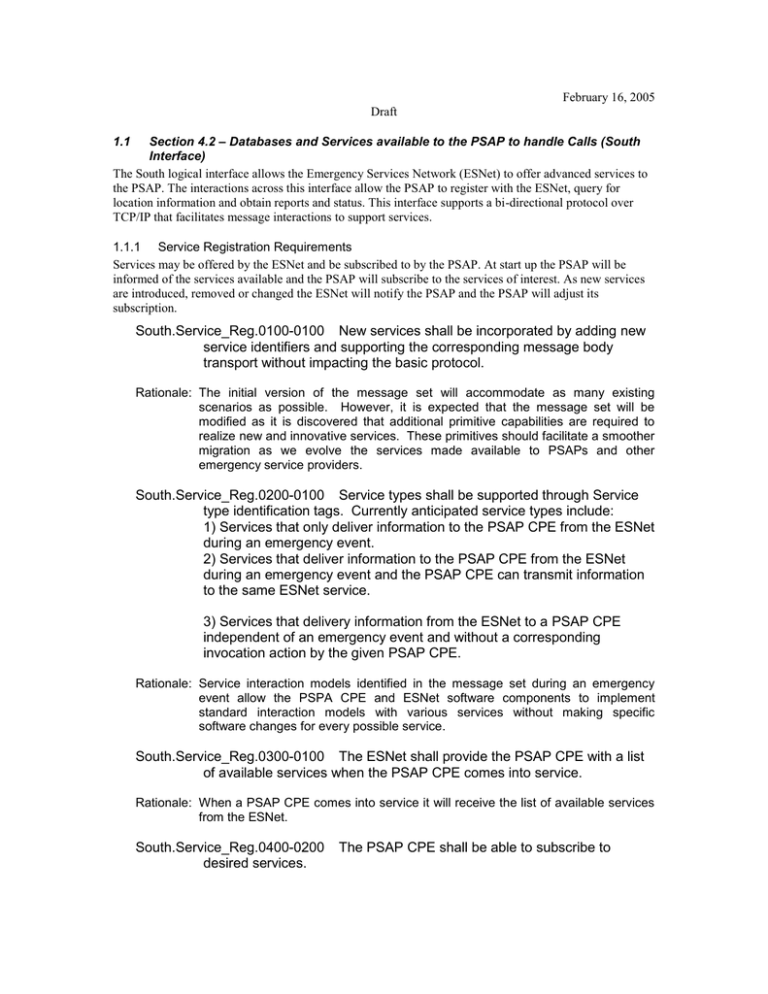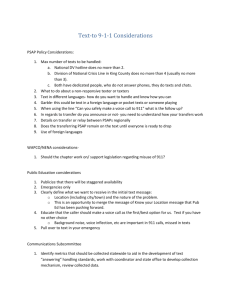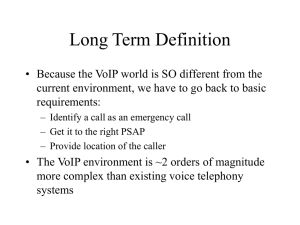February 16, 2005 Draft
advertisement

February 16, 2005 Draft Section 4.2 – Databases and Services available to the PSAP to handle Calls (South Interface) The South logical interface allows the Emergency Services Network (ESNet) to offer advanced services to the PSAP. The interactions across this interface allow the PSAP to register with the ESNet, query for location information and obtain reports and status. This interface supports a bi-directional protocol over TCP/IP that facilitates message interactions to support services. 1.1 1.1.1 Service Registration Requirements Services may be offered by the ESNet and be subscribed to by the PSAP. At start up the PSAP will be informed of the services available and the PSAP will subscribe to the services of interest. As new services are introduced, removed or changed the ESNet will notify the PSAP and the PSAP will adjust its subscription. South.Service_Reg.0100-0100 New services shall be incorporated by adding new service identifiers and supporting the corresponding message body transport without impacting the basic protocol. Rationale: The initial version of the message set will accommodate as many existing scenarios as possible. However, it is expected that the message set will be modified as it is discovered that additional primitive capabilities are required to realize new and innovative services. These primitives should facilitate a smoother migration as we evolve the services made available to PSAPs and other emergency service providers. South.Service_Reg.0200-0100 Service types shall be supported through Service type identification tags. Currently anticipated service types include: 1) Services that only deliver information to the PSAP CPE from the ESNet during an emergency event. 2) Services that deliver information to the PSAP CPE from the ESNet during an emergency event and the PSAP CPE can transmit information to the same ESNet service. 3) Services that delivery information from the ESNet to a PSAP CPE independent of an emergency event and without a corresponding invocation action by the given PSAP CPE. Rationale: Service interaction models identified in the message set during an emergency event allow the PSPA CPE and ESNet software components to implement standard interaction models with various services without making specific software changes for every possible service. South.Service_Reg.0300-0100 The ESNet shall provide the PSAP CPE with a list of available services when the PSAP CPE comes into service. Rationale: When a PSAP CPE comes into service it will receive the list of available services from the ESNet. South.Service_Reg.0400-0200 desired services. The PSAP CPE shall be able to subscribe to Rationale: Through a prearranged method the PSAP CPE will be authorized to subscribe to certain services. The ESNet will send the list of authorized services to the PSAP CPE when the PSAP CPE connects and the PSAP CPE will accept those services. The ESNet will not provide services to a PSAP CPE to which the PSAP has not subscribed. South.Service_Reg.0500-0100 When new services are added, removed or changed, the ESNet shall inform the PSAP CPE of the change of available services. Rationale: There may be situations where the ESNet sends the list of services during an active session. It may be that a service has been added or a service has been removed. 1.1.2 Emergency Event Processing Requirements Emergency Event processing allows the PSAP to query for location information and receive information as it is received. Within the ESNet, data may be retrieved internally, sourced from other networks or other services may be informed of an Emergency Event depending upon the services associated. An Emergency Event creates the context of a dialog which starts when an event is received at the PSAP and the PSAP queries for location information. Within the Emergency Event, updates can be requested, responses are provided, events may be bridged with other PSAPs, etc. An Emergency Event dialog is closed when the PSAP concludes its activity associated with the specific event. South.EmergEvent.0100-0100 The Emergency Event processing shall support the interleaving of queries and responses for multiple Emergency Events. Rationale: The PSAP CPE may handle multiple calls simultaneously. So the PSAP CPE may possibly have multiple Emergency Call Events open at the same time. The response to queries for an Emergency Event may vary based upon where data is located and the type of call. For example the response for a wireless Phase 2 call may require significantly more time than a wireline call and may result in multiple responses from the ESNet to the PSAP CPE. South.EmergEvent.0200-0100 The Emergency Event processing shall provide a method for the ESNet to correlate an emergency event submitted from a PSAP CPE with all responses generated by the ESNet and sent to the PSAP CPE. The ESNet shall assign each Emergency Event a unique identifier (Emergency Event Identifier [EEID]) to correlate subsequent responses. Rationale: For each message that is of a query/response type a method such as a message ID is required to allow the originating party to correlate the request with the response. The Emergency Event Identifier shall be used to correlate all messages associated with a specific event. South.EmergEvent.0400-0100 When an Emergency Call Event is complete the PSAP CPE shall issue an event complete message to the ESNet. It may pass in the event complete message any local notes that may have been collected during the processing of the event or may send notes after the event complete message is transmitted. Rationale: When the call is terminated and the call taker completes activity associated with the event, a call termination message must be sent to the ESNet to allow it to clean up transient data and log the event. This notification also allows the ESNet 2 to recognize that no further services for the event are to be sent to the PSAP CPE. South.EmergEvent.0500-0100 When a PSAP CPE issues an Emergency Event to the ESNet, the ESNet shall determine if there is an existing event open for the given Event Key identified for the event. If there is an open event, the PSAP CPE shall be notified that another PSAP is currently engaged in an open event and the ESNet will use the existing Emergency Event Identifier for the additional responses. Rationale: These features allow correlation of the same events across call takers and can facilitate cooperative features among or between the call takers and other users. 1.1.3 Bridge Services When a PSAP receives a call it may determine that it may bridge on another PSAP or individual to assist in the event management. The PSAP will notify the ESNet of this situation and the ESNet will correlate Emergency Event related information between/among the bridge parties. South.Bridge.0100-0100 When an emergency call is bridged from a given PSAP CPE to a secondary destination, the PSAP CPE shall notify the ESNet that the bridging is taking place. The PSAP CPE shall include to the destination information such as TN and/or bridging destination identifier. Rationale: Having the PSAP CPE notify the ESNet will allow the ESNet to implement services and recognize multiple accesses for the same call event. South.Bridge.0200-0100 The PSAP CPE may pass any local notes, supplemental information and TTY text that may have been taken that relate to the event, if available, from the PSAP CPE to the ESNet gateway. Rationale: When a call is bridged there may be useful data collected at the originating PSAP which could be helpful at the bridged to PSAP. If the originating PSAP notifies the ESNet of the event and passes the data, it can be available to the bridged to PSAP when it queries. South.Bridge.0300-0100 Upon detecting a previously existing event, the ESNet shall return all relevant event information along with the existing Emergency Event Identifier and any local notes, supplemental information and TTY text that may have been uploaded to the ESNet. Rationale: When a call is bridged and the bridged to PSAP queries, the ESNet may associate the events and pass the existing Emergency Event Identifier and any local notes that may have been provided. South.Bridge.0400-0100 The protocol shall support a message notifying a given PSAP CPE that an additional PSAP has joined a given call event as identified by the Emergency `Event Identifier. Both the existing PSAP and the joining PSAP receive this message. Rationale: This capability enables a PSAP to implement services and features based on knowing that another call taker with these capabilities is engaged in the given call event. 3 1.1.4 Information Discrepancy Service When a call is received by a PSAP and information displayed, thre is the potential for a discrepancy between what is displayed and information obtained from the caller. An information discrepancy service allows this discrepancy to be sent to the appropriate administrative agency for correction. The agency then may return a tracking ticket and notify the requesting PSAP of the disposition. South.DISC.0100-0100 The Information Discrepancy Service shall support an information discrepancy notice from the PSAP to the ESNet if a specific body of information provided in an Emergency Call Event is found to contain errors. The message need not be sent from the PSAP to the ESNet during the actual open emergency event message sequence. Rationale: Automated reporting of information errors (such as ALI) can result in dramatic 9-11 data improvement and reduction of timeframes required to report problems and have those problems corrected in the information source providing database. South.DISC.0200-0100 Once the receiving agency receives the information discrepancy report it shall return a tracking ticket to the PSAP. Rationale: A tracking ticket will allow the requesting PSAP to follow the disposition of the discrepancy. South.DISC.0300-0100 Once the information discrepancy is resolved by the managing agency a status report shall be sent to the original requesting PSAP. Rationale: The returning of the final disposition of the discrepancy allows the requesting PSAP to know that the issue has been handled. 1.1.5 PSAP Misroute Reporting Service South.Misroute.0400-0100 A misroute discrepancy notice from the PSAP to the ESNet shall be supported if the call taker detects that a call directed to their PSAP should have been directed to a different PSAP. This message will support a textual reason description field that can be filled in by the call taker. Rationale: Call misroute reports are another common problem that needs automated management. South.Misroute.0200-0100 Once the receiving agency receives the information discrepancy report it shall return a tracking ticket to the PSAP. Rationale: A tracking ticket will allow the requesting PSAP to follow the disposition of the discrepancy. South.Misroute.0300-0100 Once the misroute discrepancy is resolved by the managing agency a status report shall be sent to the original requesting PSAP. Rationale: The returning of the final disposition of the discrepancy allows the requesting PSAP to know that the issue has been handled. 4 1.1.6 Report and Status Services There are situations where it is useful for either the PSAP or ESNet components to request information of the other to obtain status, e.g. related to active events, or to provide reports that may be used by authorized agencies. South.REPORT.0100-0100 A given PSAP shall have the capability to request the status of a specific or all Emergency Call Events that are active within the ESNet pertaining to that PSAP CPE or related to the PSAP (group) that the given PSAP CPE belongs. Rationale: The call taker, supervisor, or administrator at a PSAP should have the capability to obtain the list, and relevant information, for all active Emergency Call Events relating to their call taker position or their PSAP in order to reconcile the status of processing of the event. South.REPORT.0200-0100 The ESNet shall have the capability to request the status of a specific, or all, Emergency Call Events that are active for a given PSAP. Status will consist of information regarding in-progress or complete emergency events, engaged in a bridge or not, IM active or not, Emergency Event Identifier, and whether the call contains optional local notes. Rationale: The ESNet will need the ability to update the state machine processing logic for a given or for all events for a given PSAP connection in order to ensure processing logic and to detect “hung” emergency event processing situations. South.REPORT.0300-0100 The PSAP CPE shall have the capability to request an activity report regarding recently concluded Emergency Call Events. Rationale: It may be useful for the PSAP to request a management information report that may be used to survey historical activity. This report may include events segmented by class of service, events received over a reporting window (day, week, etc.) and other such selection criteria. Sourth.REPORT.0400-0100 The ESNet shall have the capability to request a configuration report from the PSAP. Rationale: For trouble shooting and management it is useful for an administrator at the Emergency Service Provider to obtain current information regarding the configuration parameters of the PSAP. This report may include network connections, number of position supported by the PSAP and other such configuration-related information. 1.1.7 Network Requirements The network between the PSAP and the ESNet will be a private or virtual private network based upon TCP/IP. It will have scalable bandwidth to support new enhanced services. The network must be robust to support all categories of media, including text, graphics and video based upon the applications that are supported. South.Network.0100-0100 The Network between the PSAP and the ESNet shall be a private or virtual private network based upon TCP/IP. 5 Rationale: This network will be a controlled environment between the PSAP and ESNet. I.e. data transported across this network will not go across the public Internet. South.Network.0200-0100 While initial implementations may only incorporate text transmission between the PSAP and ESNet, the protocols and the corresponding network shall be capable of supporting the transmission of images, video, high resolution graphics, non real time voice, and other capabilities. Rationale: For many services simple transmission of text is sufficient. However, one of the significant advantages of this architectural concept is the opportunity to offer services that extend the communication to all types of media. If the minimal rate, e.g. 56kbs, is deployed these higher bandwidth services will be severely limited. South.Network.0300-0100 Connections between the PSAP and ESNet shall be secured TCP/IP socket connections such that advanced authorization, authentication and security features can be implemented. Rationale: TCP/IP sockets allow managed and monitored point to point application level transport. Such techniques easily extend to support strong authentication, server authentication, and content encryption. TCP/IP sockets can be established and maintained over a relative long period of time, thus, spreading the overhead of establishing and authenticating the connection over a period of time. 1.1.8 Protocol Requirements The protocol between the PSAP and ESNet will be bi-directional to support the new services that will be implemented across this interface. The protocol will allow end points to discover each other. South.Protocol.0100-0100 The PSAP CPE shall identify its initial ESNet element using logical names and naming services with standard Internet Protocol elements (e.g. DNS). Rationale: Using standard Internet Protocol techniques will allow PSAP CPE to easily and quickly identify available network elements to begin initialization. South.Protocol.0200-0100 The protocol shall support mechanisms to ensure constant monitoring of the communication capability between a given PSAP CPE and the ESNet. Rationale: Facilities must be monitored to ensure availability and proper functioning. No failure or lack of communication capability should wait to be detected upon an attempt to fulfill an emergency service event. South.Protocol.0300-0100 The protocol shall support mechanisms to negotiate appropriate connections from a specific PSAP CPE to a ESNet component using session parameters including version number and shall use standard IP techniques (e.g. Session Initiation Protocol [SIP]). Rationale: Mechanisms to support upgrading the protocol within a production environment and managing compatibilities is vital. An infrastructure that allows appropriate negotiation of connections will be extensible to other scenarios. 6 South.Protocol.0400-0100 The protocol shall allow each entity (PSAP CPE and ESNet component) to identify its implementation version during connection initialization to allow interacting components to verify compatibility of their message sets. Rationale: Capabilities should be put into the message set to accommodate the identification of supported versions of the protocol between two end points. This will allow the PSAP CPE or ESNet component to revert back to a compatible version or reject incompatible partners. These primitives should facilitate a smoother migration as we evolve the services made available to PSAPs and other emergency service providers. South.Protocol.0500-0100 Behavior rules shall specify that if incompatible message sets are determined, the components shall either adjust behavior appropriately or shall reject interaction between incompatible versions. Rationale: Components can be upgraded without affecting service availability. They can also detect components which are no longer supported and could cause faults in the overall ESNet infrastructure. South.Protocol.0600-0100 Facilities and algorithms used in failure and recovery situations shall be constantly exercised to ensure they are operating properly. Rationale: Capabilities used to restore service or work around faults should not wait for a problem situation before being exercised to ensure the facility is working properly. South.Protocol.0700-0100 Client and server connectivity shall be created and broken down dynamically as servers are taken into and out of service without causing abnormal processing situations or management alarm failure conditions to be initiated. Rationale: Unlike the existing fixed relationship between a PSAP link and an ALI, connections from the PSAP CPE to the ESNet component are created dynamically. These connections will be managed such that when an ESNet component server goes out of service the connection is re-established to another server. South.Protocol.0800-0100 The South interface shall support mechanisms for dynamic connections and load balancing such that components can be introduced into the network in an incremental fashion without impacting existing services or operation. Also, so that PSAP CPE can be added and connection balanced across the available ESNet Components. Rationale: A key architectural element is the scalability of the network so components can be added in a production environment without impacting immediate processing capabilities or services. Routinely balancing connections will allow ESNet components to be put into service or taken out of service without requiring scheduled maintenance or requiring an infrastructure that sends notices to elements requesting connection changes 7 South.Protocol.0900-0100 The protocol between the PSAP CPE and the ESNet shall be bi-directional. That is, for some services the PSAP CPE will initiate the action and for others the ESNet will. Rationale: The message set used between the PSAP CPE and ESNet must evolve away from the simple query/response of the legacy interface. Depending upon the service either the PSAP CPE or the ESNet may initiate the interactions. Certain messages are valid only when sent by the PSAP CPE and others are valid only when sent by an ESNet component. Each message in the protocol has a specific purpose and required data elements. South.Protocol.1000-0100 The protocol shall support the application model where the PSAP CPE corresponds to a unique identity as exposed to the ESNet. Rationale: A PSAP is made up of a set of PSAP CPE connections. Having each unique user idenity correspond to a given connection allows a simpler application protocol and simplifies administration and security. 1.1.9 Security/Privacy The interface between the PSAP and ESNet will provide security such that endpoints may be authenticated and authorized to use services. Encryption is required to assure that user data is protected. South.SEC.0100-0100 The ESNet shall enforce secure authentication with the PSAP CPE. All users shall be authenticated before being allowed to request services from the ESNet. Rationale: In order to validate that the PSAP CPE is authenticated, security measures such as login/password, certificates and tokens are used to authenticate the PSAP CPE. Only authenticated PSAP CPE are allowed to interact with a given ESNet. Strong authentication between network elements can be used and incorporates such methods such as authentication tokens and digital certificates. South.SEC.0200-0100 The interface shall support password-only (weak) or password and token (strong) user authentication between a PSAP CPE and ESNet based on the configuration of the ESNet. Rationale: Although strong authentication is highly recommended, not all environments may require or allow strong authentication models and, therefore, the authentication structure must be flexible. South.SEC.0300-0100 The South interface shall support secure PSAP CPE authentication. If required by the ESNet, all PSAP CPE shall be authenticated via digital certificates before being allowed to access services from the ESNet. Rationale: Although strong CPE authentication is highly recommended, not all environments may require or allow strong PSAP CPE authentication models therefore the authentication structure must be flexible. 1.1.10 Maintenance The interface will incorporate best practices for maintainability. PSAP CPE and ESNet components must be able to come into service and go out of service without impacting the over service. 8 South.Maint.0100-0100 Application level sanity checks shall verify the communications between the PSAP and ESNet by exchanging heartbeat messages during periods of inactivity. Rationale: TCP/IP will verify transport level protocol sanity. A method is necessary to ensure, while application level connections are otherwise idle, that application level capabilities exist at both ends of the interface before an emergency event occurs. It must be recommended in the behavior rules that both ends issue a report message and create local application level alarms upon detection of a communication availability failure. South.Maint.0200-0100 The PSAP CPE shall shutdown for normal maintenance without creating an error condition within the ESNet. Therefore, the ESNet component shall not raise alarms, shall suspend availability monitoring of the PSAP CPE’s connection and shall implement shutdown protocols with its PSAP CPE. Rationale: This will enable a PSAP CPE to go to a quiescent state in a clean and uninterrupted manner. South.Maint.0300-0100 An ESNet component shall shutdown for normal maintenance without creating an error condition within the PSAP. Therefore, the PSAP CPE shall not raise alarms and shall suspend availability monitoring of the ESNet components connection. The PSAP CPE shall establish a new connection to another ESNet component and begin submitting all new emergency events on the new connection. Rationale: This will enable an ESNet component to go to a quiescent state in a clean and uninterrupted manner. The PSAP CPE should attempt to complete all transactions and open emergency events in progress and new transactions shall be directed to the new ESNet Conponent connection. 1.2 Section 4.4 Connection to Local, Regional, State and Federal Authorities and peer connections (North Interface) The North logical interface allows the PSAP to access advanced services that may be offered by the Emergency Services Network (ESNet) or other information sources. This interface supports a bi-directional protocol over TCP/IP that facilitates message interactions to support services. 1.2.1 Network Requirements Requirements of Section 1.1.7 apply 1.2.2 Protocol Requirements Requirements of Section 1.1.8 apply 1.2.3 Security/Privacy Requirements of Section 1.1.9 apply 1.2.4 Maintenance Requirements of Section 1.1.10 apply 9 1.2.5 Service Registration Requirements Requirements of Section 1.1.1 apply 1.2.6 Instant Messaging Service North.IM.0200-0100 An Instant Messaging service shall support the ability for a given PSAP user to join a Jabber Instant Messaging session related to an open emergency event that it is currently engaged in as determined by an Emergency Event Identifier. Rationale: Provides local control over IM for a given PSAP user to join a Jabber IM session. The IM user could be a call taker, an administrator, or other user. North.IM.0300-0100 The Instant Messaging Service shall support the ability for a PSAP IM session participant to drop from an IM session. Rationale: Allows a PSAP user to exit an IM session. North.IM.0400-0100 The Instant Messaging Service shall notify other participants in an IM Session that a given participant has dropped or has been added. Rationale: Allows sharing of the state of the IM Session with other IM Session participants. North.IM.0500-0100 The Instant Messaging Service shall support sending IM Messages to other IM session participants and receiving messages from other participants. Messages are sent to and/or received from all users engaged in the given IM session. Rationale: Allows instant message communication between participants that have joined an IM session. 1.2.7 Notification Services North.Notify.0100-0100 The Notification Service shall provide the capability for an authorized agency to send an informational message (Notification Service Message) to a specific PSAP, a group of PSAPs or all PSAPs. Rationale: Notification Service is a native service that allows an authorized “agency” to send a message to one or more PSAPs. An example may be an Amber Alert advisory. North.Notify.0200-0100 The Notification Service shall provide the capability for a PSAP to send an informational message (Notification Service Message) to a specific PSAP, a group of PSAPs, all PSAPs or authorized agencies. Rationale: Notification Service is a native service that allows a PSAP to send a message to one or more PSAPs or authorized agencies. An example may be an Amber Alert advisory. 10 North.Notify.0300-0100 The Notification Service shall have the capability of sending all types of media such as text, multimedia clips, etc. Rationale: All categories of media will be available to the PSAP with the notification service. 11





